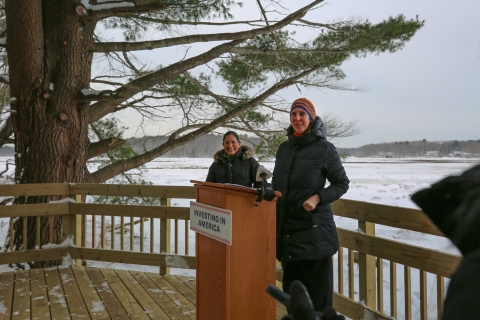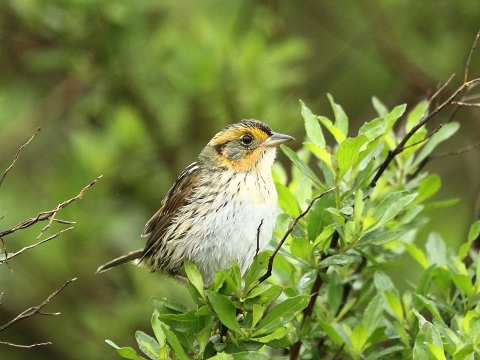On a cold January morning, snow blanketing the ground and stuck to tree trunks and branches, Secretary of the Interior Deb Haaland and Martha Williams, Director of the U.S. Fish and Wildlife Service, met with partners and collaborators in New Hampshire. The group gathered to celebrate a fresh path forward in restoring this globally rare ecosystem.
At the site, Secretary Haaland announced that a new initiative to save coastal marshes has taken shape — the Salt Marsh Keystone Initiative, a critical part of the Biden Administration’s Investing in America Agenda. Efforts are being made to support work from many agencies, including the Service and its partners — coordinating efforts to restore and realign coastal salt marshes for the benefit of fish, wildlife and people.
“Through targeted investments and local collaboration, this new Salt Marsh Keystone Initiative will help to protect the more than 44 million Americans who live on the Atlantic Coast from coastal flooding, safeguard important wildlife, such as the salt marsh salt marsh
Salt marshes are found in tidal areas near the coast, where freshwater mixes with saltwater.
Learn more about salt marsh sparrow, and foster partnerships across federal, Tribal, state and local governments,” Secretary Haaland noted.
A keystone to conservation
When salt marshes are healthy, they can serve as a buffer for severe storm events along the shore. They absorb flooding from massive waves and heavy rains. Additionally, their dense peat-like structure can store carbon at a rate up to 50 times faster than terrestrial forests; having the carbon locked away keeps it from venturing into the atmosphere and perpetuating rising temperatures and climate change climate change
Climate change includes both global warming driven by human-induced emissions of greenhouse gases and the resulting large-scale shifts in weather patterns. Though there have been previous periods of climatic change, since the mid-20th century humans have had an unprecedented impact on Earth's climate system and caused change on a global scale.
Learn more about climate change .
"Salt marshes, like this one, provide important habitat to native species and offer communities clean water and flood protection," said Williams. "Over the last decade, the Service has participated in locally led, partnership-driven conservation at salt marshes throughout the Northeast to apply restoration techniques that benefit birds like the saltmarsh sparrow, fish, and shellfish. Together, we’re working to protect these most essential ecosystems, conserve at-risk species, and increase resilience to sea level rise.”
Salt marsh is home to many species, including the at-risk saltmarsh sparrow, which exists nowhere else. They nest only in the salt marshes of the Northeast, and their numbers are declining at an alarming rate as rising seas flood nests and drown chicks. Over the last decade, the Service has worked with partners at salt marshes throughout the Northeast to apply restoration techniques that benefit birds like the saltmarsh sparrow, fish and shellfish.
Past success informs future triumph
The Northeast has led the way on salt marsh restoration efforts, expanding on lessons learned from Hurricane Sandy in 2012. By creating runnels to channel the water out of flooded marsh, and restoring marshes heavily ditched from farming or filled in to battle mosquitos, the Service and its partners have demonstrated just what it takes to bring back marshes from the brink — and with focused funding through the keystone initiative, this work can and will continue into the future.
Nature provides, when and if we re-create conditions that have always supported it and undo the mistakes of our past.





